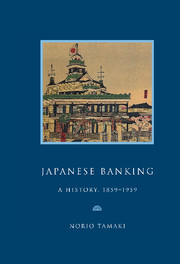Book contents
- Frontmatter
- Contents
- Preface
- Genealogy of leading Japanese banks, 1859–1959
- List of abbreviations
- Map
- Part I A bankrupt Shogunate, 1859–1868
- Historical background
- 1 Japanese merchant bankers: ryogae, 1859–1868
- 2 A bankrupt regime, 1859–1866
- 3 Ryogae struggling for survival, 1859–1868
- 4 The arrival of western banking, 1863–1868
- Part II The Meiji Restoration: monetary confusion and banking experiments, 1868–1881
- Part III Matsukata, the wizard of Japanese banking, 1881–1897; the Yokohama Specie Bank (1880) and the Bank of Japan (1882)
- Part IV The Japanese on the London money market, 1897–1911
- Part V War, the Japanese boom years, 1911–1919
- Part VI Crisis and the road to war, 1919–1937
- Part VII Complete commitment, struggle and defeat, 1937–1945
- Part VIII American ‘democratisation’ and the search for growth, 1945–1959
- An extraordinary century, 1859–1959
- Appendices
- Notes
- Bibliography
- Index
1 - Japanese merchant bankers: ryogae, 1859–1868
Published online by Cambridge University Press: 03 February 2010
- Frontmatter
- Contents
- Preface
- Genealogy of leading Japanese banks, 1859–1959
- List of abbreviations
- Map
- Part I A bankrupt Shogunate, 1859–1868
- Historical background
- 1 Japanese merchant bankers: ryogae, 1859–1868
- 2 A bankrupt regime, 1859–1866
- 3 Ryogae struggling for survival, 1859–1868
- 4 The arrival of western banking, 1863–1868
- Part II The Meiji Restoration: monetary confusion and banking experiments, 1868–1881
- Part III Matsukata, the wizard of Japanese banking, 1881–1897; the Yokohama Specie Bank (1880) and the Bank of Japan (1882)
- Part IV The Japanese on the London money market, 1897–1911
- Part V War, the Japanese boom years, 1911–1919
- Part VI Crisis and the road to war, 1919–1937
- Part VII Complete commitment, struggle and defeat, 1937–1945
- Part VIII American ‘democratisation’ and the search for growth, 1945–1959
- An extraordinary century, 1859–1959
- Appendices
- Notes
- Bibliography
- Index
Summary
Prior to the arrival of the demanding foreigners on Japanese soil on 1 July 1859 there was a quasi-banking system operating in Japan. The bakufu government had earlier authorised certain merchants, ryogae, to trade in Edo (Tokyo) and Osaka. With the reluctant acceptance by the bakufu of treaty ports at Yokohama, Nagasaki, and Hakodate, at which foreigners had the right to reside and trade, the government licensed a handful of ryogae to operate in Yokohama and Nagasaki. Japanese and foreigners using silver Mexican dollars (which were the universal currency in the East at this time) made their financial arrangements on a day-to-day ad hoc basis, paying partly in cash and partly by barter. The fact that, before 1859, Nagasaki was the only port open to the Chinese and Dutch enabled various sorts of financial arrangements to develop there which provided valuable experience for the many young samurai who were to become powerful leaders in the new Japan after 1868.
The fundamental fact underlying the Japanese economic system prior to the upheaval consequent on the arrival of the foreigners was that taxes were paid in rice, in kind. Until 1873, when the system was abandoned, rice was the real currency. The commercial houses which had developed in Edo and Osaka, from which were to evolve the great present-day financial institutions of Japan, were essentially rice-handling agencies which had in the course of their business as collectors of rice taxes developed quasi-banking functions. It should also be remembered that in Japanese society at this time the merchant was socially of humble rank, classed only marginally higher than the peasant.
- Type
- Chapter
- Information
- Japanese BankingA History, 1859–1959, pp. 4 - 9Publisher: Cambridge University PressPrint publication year: 1995
- 2
- Cited by



